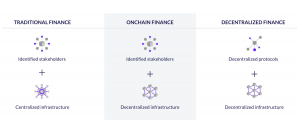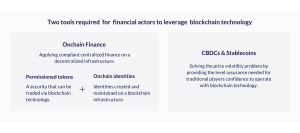In the last article we looked at the opportunities and challenges in private markets. In this article we assess whether blockchain technology could answer these challenges and spawn a new era for the private market industry.
Blockchain technology is now recognized as a suitable infrastructure to issue, transfer and manage securities across capital markets. Immutable and programmable, blockchain based solutions provide a resilient and highly transferable infrastructure and one that is accessible for private market players. Essentially, for market participants to unlock the benefits of this new technology they need to be aware of two innovations:
A NEW INFRASTRUCTURE
Blockchain technology has created a new method of transferring value that has challenged and will continue to challenge the traditional makeup of financial markets. By tokenizing assets, many of the typical, low-value and expensive operations can be automated in security offerings. This innovation essentially allows the transfer of value from one party to another in a more secure and efficient way than is seen in traditional capital markets.
More specifically, DeFi (Decentralized Finance), the concept of a financial ecosystem living digitally on a distributed infrastructure, has been booming in 2020. 12 This innovation has largely been developed on the Ethereum network and has been used to drive participating parties to lend and borrow through DeFi protocols. For the moment, the usage and activity surge has been driven by holders of stablecoins and cryptocurrencies, who have dealt directly with DeFi protocols without the need for any intermediary. Stablecoin usage has been a key driver for DeFi, along with users of cryptocurrencies such as Bitcoin. In the summer of 2020, tokenized Bitcoin on the Ethereum network overtook the amount of Bitcoin on the Lightning Network, the layer built on the Bitcoin blockchain to allow two parties to transact with one another. It is a notable moment for the DeFi boom, but hurdles remain for those with security tokens and real assets to interact with DeFi, as the responsibilities of issuers and the rights of investors must be enforced.
COMPLIANCE ENFORCEMENT: ONCHAIN FINANCE
For financial actors to interact with this new network, there are two tools that are required for them to leverage all the advantages of blockchain technology. The first aspect that’s required is the need for firm’s to apply control and compliance to this shared infrastructure. Since 2008, regulations have been getting stricter and stricter for market actors These regulations have been getting stricter and stricter for firms to follow and they have been eating into the profitability of financial institutions. Onchain Finance represents the notion of applying compliant centralized finance on a decentralized infrastructure, meaning the stakeholders (issuers, agents, investors) are represented on the blockchain and the market rules and regulations are complied with and improved on this new infrastructure.

In its simplest terms, Onchain Finance consists of two blockchain-based technological layers:
Permissioned Tokens
These are the representations of a security that can be traded via blockchain technology. As such, they are permissioned and the transfers are controlled by a set of smart contracts deployed on the blockchain . This ensures token holders meet KYC and eligibility rules defined by the issuer (via their legal team) and enables the dynamic white listing of investors across the entire life of the security token.
Onchain Identities
For permissioned security tokens to be distributed to eligible investors, it’s essential for investor identities to be known. Onchain identities, acting almost like an investment passport that’s reusable from offering to offering, are created and maintained on a blockchain infrastructure. These identities are created on behalf of all parties in the subscription and transactional process of security tokens (issuer, KYC provider, security token administrative agent and obviously, investors). Investors are able to make their information known to third parties on request and can enrich their data with relevant qualifying information such as accreditations, KYC checks, proof of identity etc.
THE BENEFITS OF DIGITAL CURRENCIES
The second aspect is the usage of a Central Bank Digital Currency (CBDC) or a stablecoin issued by a financial institution to solve the price volatility problem. Stablecoins offer a solution but do not give the level of assurance that’s required for traditional players to fully adopt the blockchain. As previously noted, stablecoin use has risen, but not amongst the traditional financial players. This requirement is known, too. CBDCs are currently under development by the world’s largest nations. These government issued currencies would provide the level of assurance needed for traditional players’ confidence to operate with blockchain technology and act as a gateway into asset tokenization.
These pieces to the puzzle will enable blockchain to transform private markets by delivering three core benefits for the industry:
Data transparency
The digitization of private market securities is likely to deliver improvements with regards to data transferability and therefore market transparency. Information about the issuer and the characteristics of a certain asset could be improved, along with the potential to improve the dissemination of information. This could improve price discovery for market participants but also sustainable finance or impact investments more broadly, an area which is heavily reliant on trustworthy information. By bringing visibility over currently opaque value chains, proofs of sustainability could easily be embedded into tokenized securities or security token (ratings, green labels, etc) and thereby significantly improve the level of confidence that investors can place into this kind of investment.
Distributed market
By replacing the currently restricted and fragmented market infrastructures with a globally shared one, issuers can target a wider group of investors from around the world who in turn have broader investment options at their disposal. Moreover, it is about providing global reach to issuers as opposed to restricted markets and also improving investability from the investors perspective, a win-win situation. Indeed, once hosted on a blockchain, a security token can be accessed by eligible investors in the blink of an eye across the globe using any connected device. This is potentially a significant opportunity for those in private markets as issuers can take advantage of a global network with little added cost and capital formation for issuers is improved as they have more investors to target.
Transfer of value and improved liquidity
Due to inefficient markets infrastructure, privately issued securities are difficult to trade and are therefore notoriously illiquid. The use of blockchain allows value to circulate seamlessly by bringing digital trust, as it solves for the “double spending” problem. More transparency and a greater dispersed information within the market, along with immutability and the utilization of a faster and more efficient transfer of value will contribute to the improvement of private market liquidity. Value that’s currently locked up in assets will be freed and traded between eligible investors on a seamless and accessible infrastructure.
The new development of a decentralized infrastructure poses some very attractive benefits for operators in private markets. Particularly in the secondary market, where private markets are currently restricted on both the buy and sell sides, this new infrastructure could bring in a new era in private markets. We discuss how the whole topic area in the ebook we published with PwC, click the image below to download.


